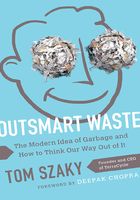
The Wisdom in Mimicking Nature
Nature simply has no concept of garbage, or useless outputs. Think about when your dog eats a plastic object, thinking it is food, or your cat chews on an extension cord. In nature all outputs are useful. It is a natural wisdom that we should echo, not in the innocent ignorance that leads some unwitting creatures to eat inedible trash but in its fundamentality.
The emerging field of biomimicry, championed by luminaries from Janine Benyus to Paul Hawken, has effectively commercialized this exact notion. They have found repeatedly that taking inspiration from nature can help us solve concrete human engineering challenges.
For example, chemical companies seeking to develop self-cleaning paint turned to the lotus—a plant that needs to keep the surfaces of its leaves clean despite living in muddy ponds and swamps (which are, admittedly, strange environments for something so beautiful and seemingly pristine). To help stay dirt-free, the lotus plant evolved tiny ridges and bumps that stop water droplets from spreading across the entire surface of its leaves. Water beads form, slide down the leaves of the plant, and carry off dirt with them. Taking a tip from nature, paint developers created paint that leaves tiny bumps when it dries—helping water form droplets to carry dirt away.
To help stay dirt-free, the lotus plant evolved tiny ridges and bumps that stop water droplets from spreading across the entire surface of its leaves. Water beads form, slide down the leaves of the plant, and carry off dirt with them. Taking a tip from nature, paint developers created paint that leaves tiny bumps when it dries—helping water form droplets to carry dirt away.
Another example of effective biomimicry is the Japanese Shinkansen “Bullet Train.” At more than 200 miles per hour, the Shinkansen is the fastest train in the world. Due to changes in air pressure and the speed of the train, every time the train came out of a tunnel it would create a micro sonic boom. The Bullet Train became something of a noise problem, with villages miles away complaining. Eiji Nakatsu, avid bird-watcher and the chief engineer on the case, found that modeling the front end of the train after the beak of the kingfisher—a bird that can dive into bodies of water with almost no splash—not only solved the sound problem but also saved 15 percent in power while increasing the train’s speed by 10 percent.
When it comes to mimicking nature to our own benefit, we should be aware that nature doesn’t innovate at the rate humans do.
To learn from nature and be responsible to it in the long run, we should focus on creating useful outputs rather than outputs that are useless (and potentially toxic). It is a proposition where all stakeholders are winners.
As individual consumers, we should look to buy products that are made from natural materials (their by-products make for useful outputs), ideally avoiding complex materials altogether. By consciously controlling our consumption and buying products that produce useful outputs instead of useless ones, we can take a big step toward eliminating the idea of garbage.